You can’t fix what you don’t understand—and when it comes to your employees, silence isn’t golden, it’s risky. An employee engagement survey is your window into what’s really going on behind the scenes. This guide will walk you through exactly how to build, run, and act on a survey that actually makes a difference in 2025.
Ever feel like your workforce is slowly ghosting you? Not storming out. Just…clocking in, clocking out, and quietly disengaging while your business moves on autopilot.
You’re not imagining it. In fact, employee engagement is one of the most quietly powerful forces behind a thriving company—or a struggling one. And one of the simplest ways to tap into what your team is really thinking? Run an employee engagement survey.
In this guide, we’re walking you through everything you need to know to create, launch, and act on your next employee engagement survey—from writing the right questions to choosing the best tools, to measuring results that actually matter.
See how ContactMonkey’s employee survey solutions make it easy to create, send, and track internal email surveys.
Take a self-guided tour of ContactMonkey
See how our key features can streamline your internal communications.
Take product tour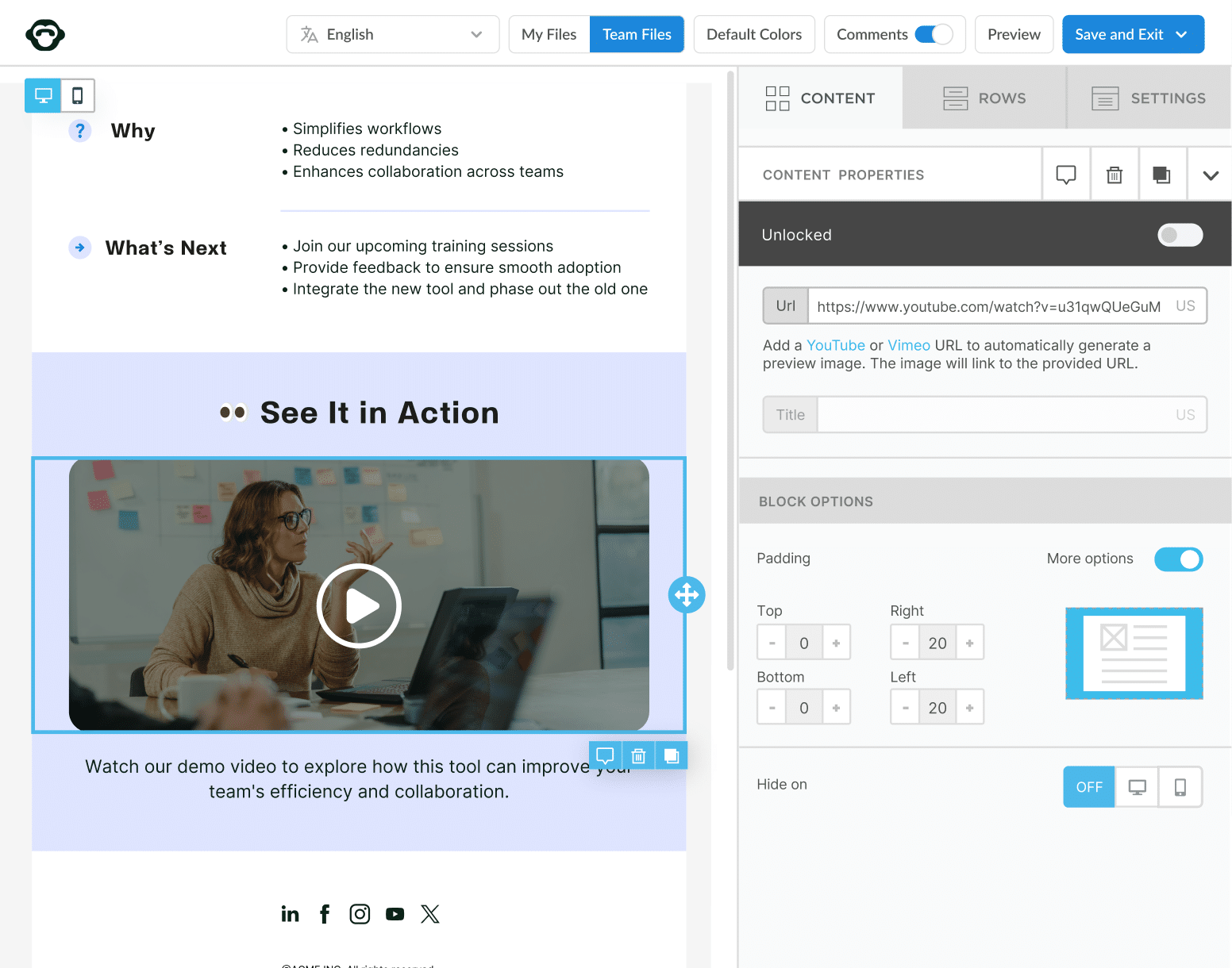
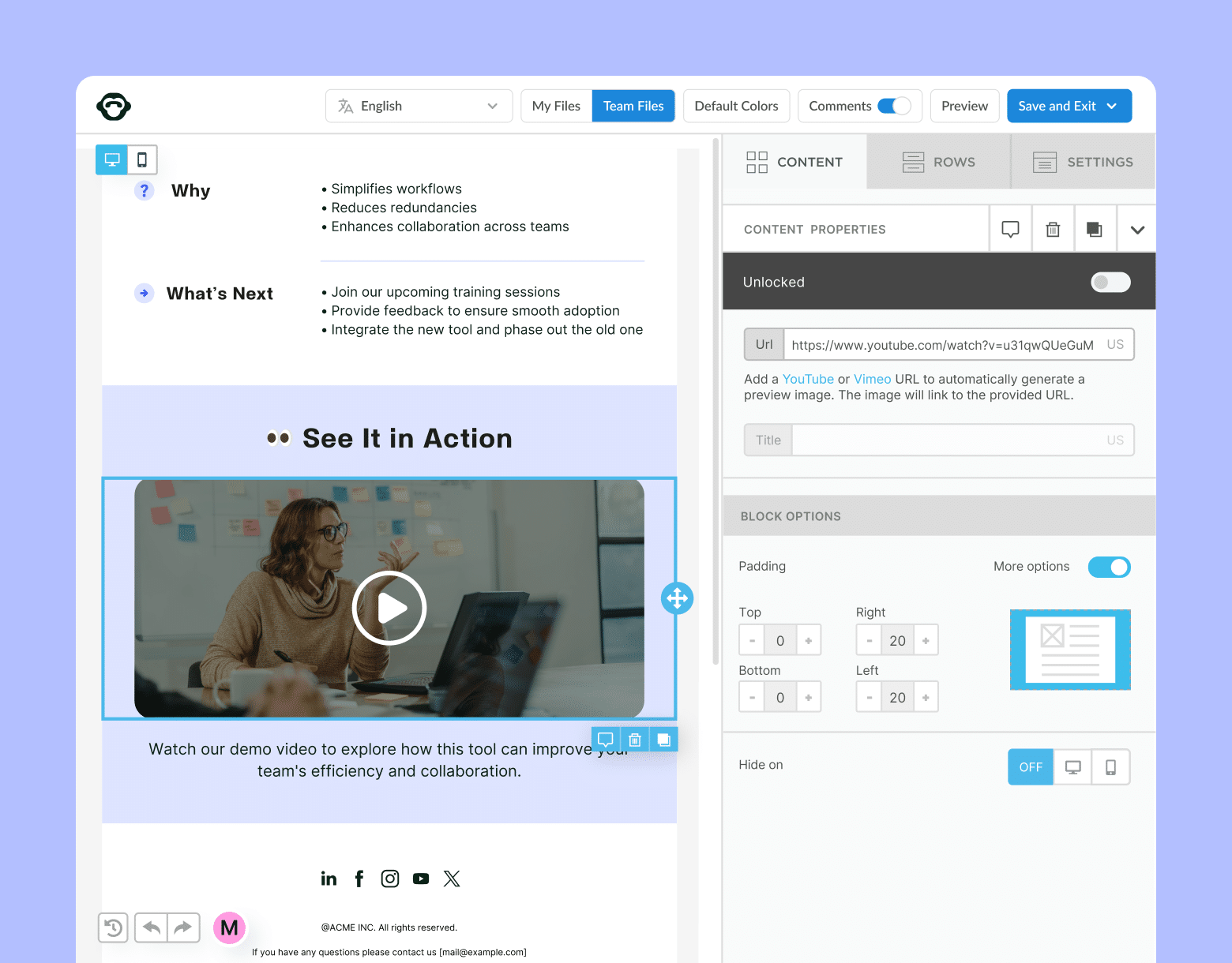
What Are Employee Engagement Surveys?
An employee engagement survey is a structured questionnaire designed to measure how motivated, satisfied, and emotionally connected employees feel in the workplace.
These surveys go beyond surface-level feedback—they capture real-time sentiment across critical employee engagement survey topics like leadership, communication, team dynamics, recognition, and career development.
Used regularly, employee engagement surveys help organizations understand what drives engagement, where pain points exist, and how to improve the overall employee experience.
Why Are Employee Engagement Surveys Important?
Running an employee engagement survey is one of the most effective ways to improve retention, productivity, and workplace morale.
According to Gallup, disengaged employees cost the global economy $8.9 trillion in lost productivity—a staggering figure tied directly to weak internal communication and lack of feedback loops.
With the right employee engagement survey questions and follow-up actions, companies can spot red flags early and build a culture where employees feel heard, valued, and invested.
More importantly, it gives your people a voice. And when employees feel heard, they’re more likely to stay, contribute, and thrive.
Create and send employee surveys for feedback
Engage staff with pulse surveys, eNPS surveys, reusable surveys, custom polls, and more. Ready to send modern emails?
Explore survey features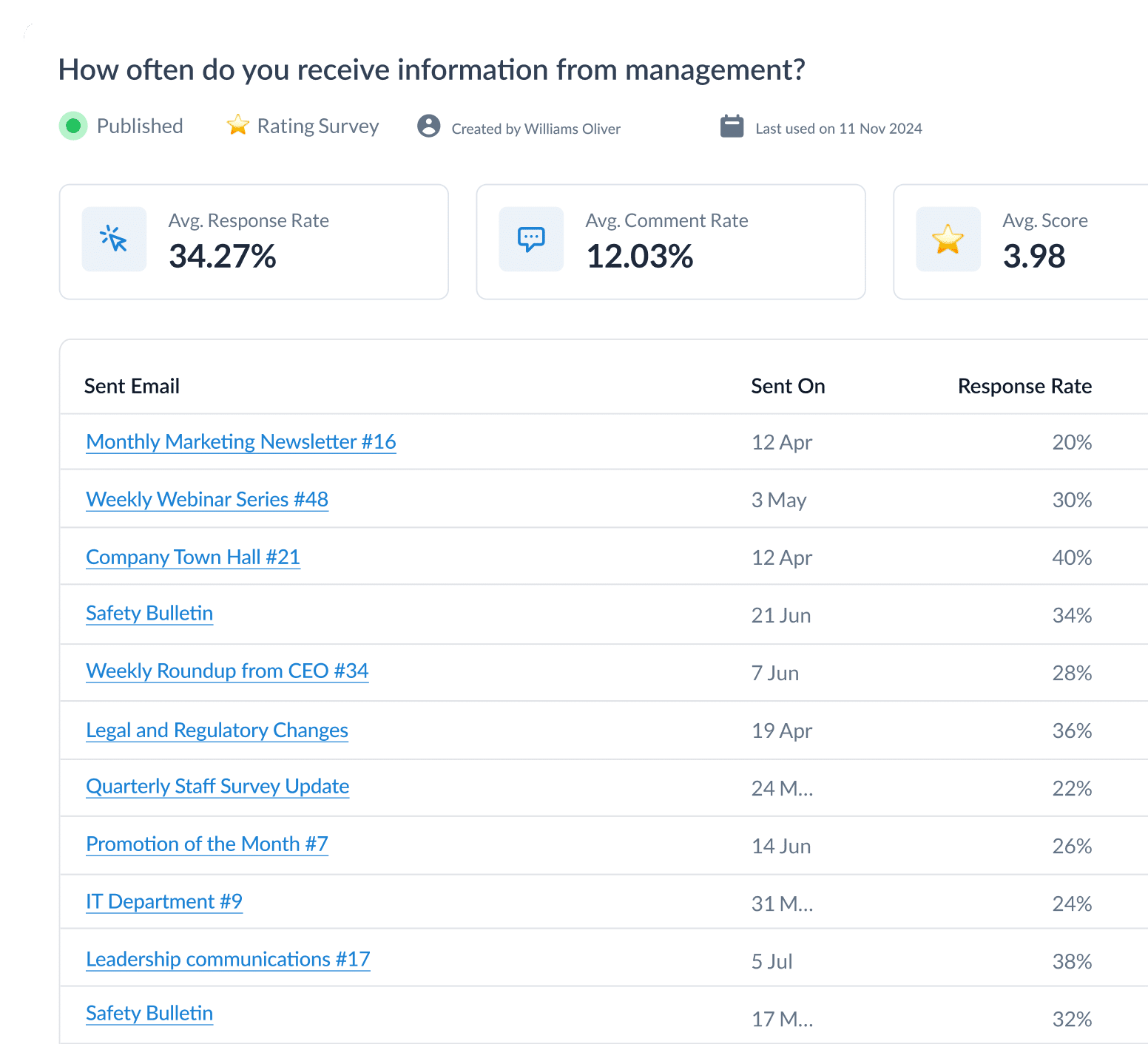
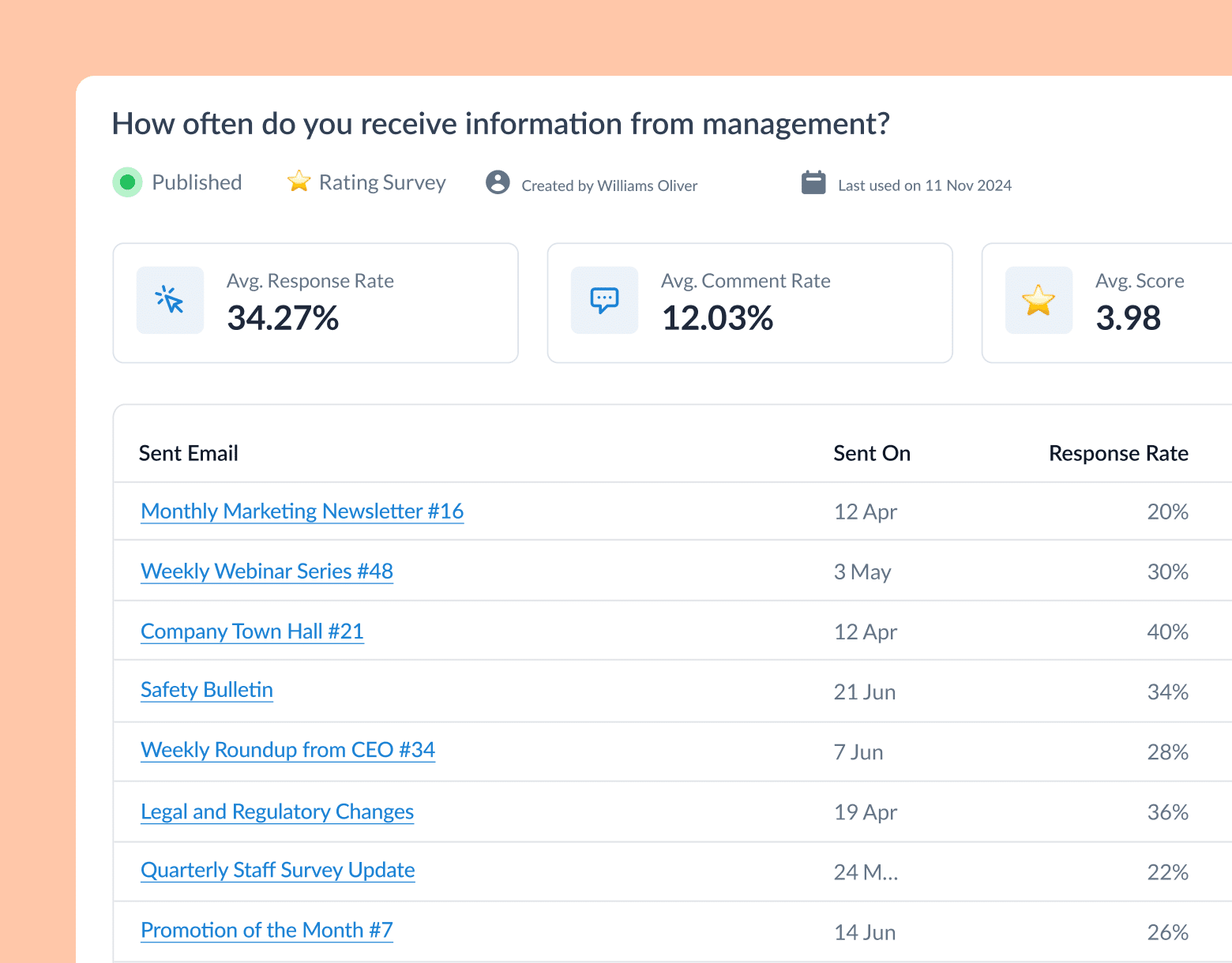
Benefits of Employee Engagement Surveys
Let’s talk upside. A well-designed employee engagement survey delivers measurable benefits for both organizations and employees—when it’s paired with the right questions, tools, and follow-up. Below you’ll find the benefits of employee engagement surveys for both organizations and employees.
Benefits of employee engagement surveys for organizations:
- Data-driven decisions: Results from your employee engagement survey help leadership make informed, strategic choices.
- Early warning signs: Uncover disengagement or burnout before it impacts productivity.
- Improved retention: Employees who feel heard through employee engagement survey questions are more likely to stay.
- Better leadership: Actionable feedback helps managers grow and lead more effectively.
- Higher productivity: Engaged employees bring more energy, creativity, and problem-solving to the table.
Benefits of employee engagement surveys for employees:
- Feeling valued: Completing an employee engagement survey signals that their voice matters.
- Empowerment: Thoughtful employee engagement survey topics allow employees to shape workplace culture.
- Stronger connection: When employees see action taken from their feedback, trust and loyalty increase.
- Clarity on expectations: Well-crafted employee engagement survey questions often highlight gaps in communication, helping employees better understand what’s expected of them.
- Improved workplace experience: Results from the survey can lead to tangible improvements in day-to-day work—like better tools, clearer processes, or more recognition.
How to Create and Conduct an Employee Engagement Survey
Creating an employee engagement survey that employees actually respond to—and that leadership actually uses—takes more than just a Google Form and good intentions. It requires structure, the right employee engagement survey tools, and a clear plan for what comes next.
Here’s a step-by-step guide on how to conduct an employee engagement survey:
Step 1: Design your employee engagement survey for maximum participation
The foundation of any successful employee engagement survey is good design—starting with a clear objective. Are you measuring overall engagement, manager effectiveness, or team morale?
Steps to design your survey effectively:
- Define a specific goal for the survey and communicate it with your team.
- Choose employee engagement survey software that supports anonymity, segmentation, and employee engagement analytics.
- Decide on cadence: annual, quarterly, or monthly pulse surveys.
- Build trust by explaining how the employee engagement survey results will be used.
PRO TIP: Use a pre-built employee engagement survey template from tools like ContactMonkey to get started faster.
Start two-way conversations and employee feedback loops
Learn how to engage staff with pulse surveys, content ratings and reactions, custom polls, and more. Ready to send modern emails?
See engagement features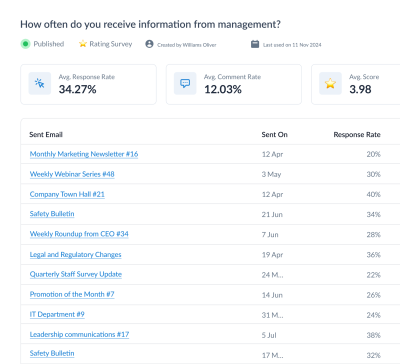

Step 2: Choose the right employee engagement survey topics to focus on
Before you start writing questions, choose the right employee engagement survey topics to explore. These themes will form the backbone of your survey and ensure your insights are actionable.
Top topics to include in your employee engagement survey:
- Manager communication and support
- Recognition and appreciation
- Opportunities for career development
- Clarity of job expectations
- Trust in leadership
- Psychological safety and DEI
- Internal communication quality
- Work-life balance and well-being
- Alignment with company values
PRO TIP: Use consistent employee engagement survey topics over time to benchmark progress and identify trends across your organization.
Step 3: Write effective employee engagement survey questions
The quality of your employee engagement survey questions will determine the quality of your data. Your questions should be clear, unbiased, and tied directly to the themes you want to explore.
Best practices for writing survey questions:
- Avoid jargon or overly complex language.
- Mix quantitative (e.g. Likert scale, yes/no) and qualitative (open-ended) questions.
- Limit your survey to 15–25 focused questions to reduce fatigue.
PRO TIP: Smart audience segmentation options in your employee engagement survey software allow you to tailor questions by department, location, or role for deeper insights.
Get powerful email analytics and reporting features
Know exactly who is opening and engaging with your employee communications and company newsletters.
Explore analytics & reporting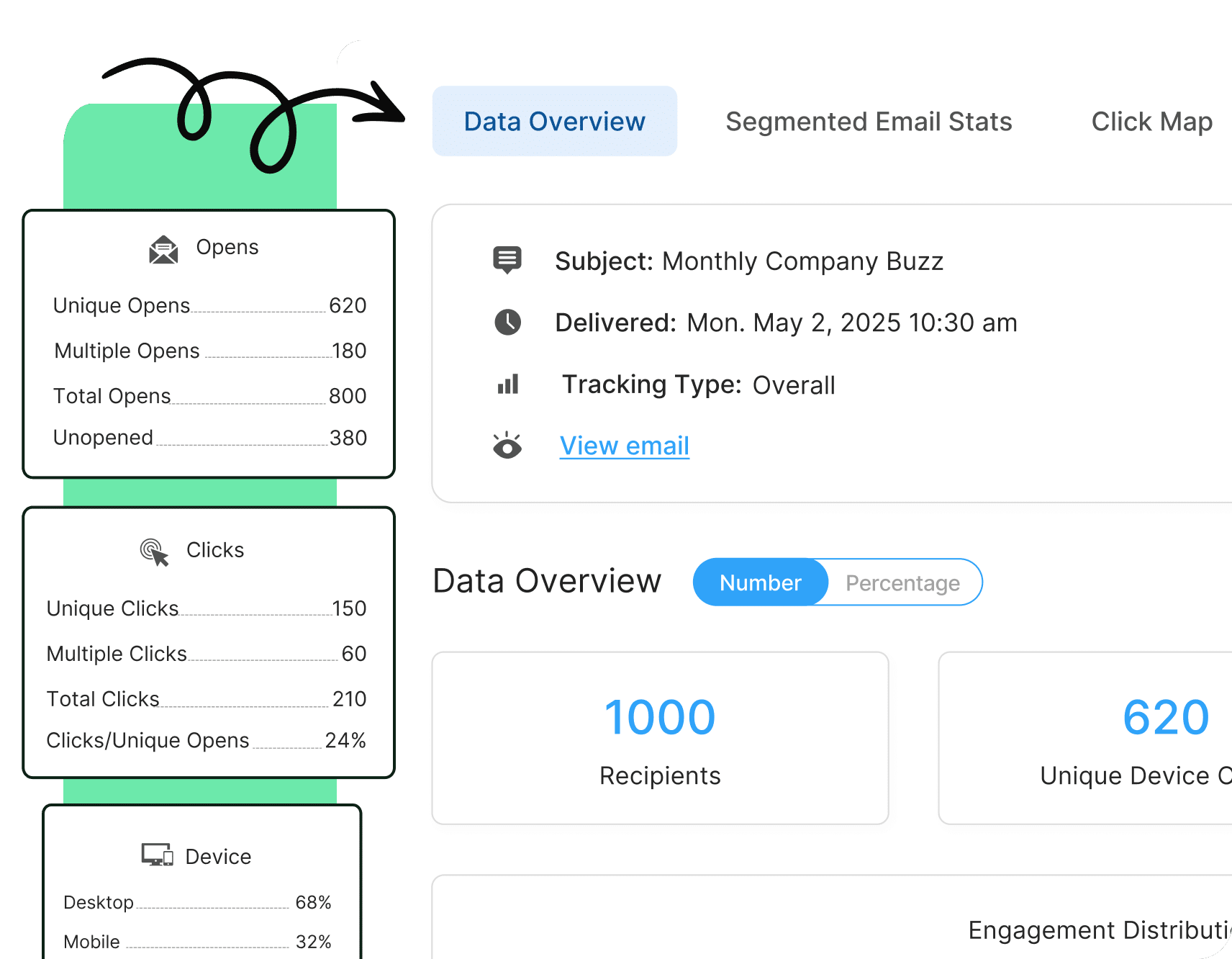
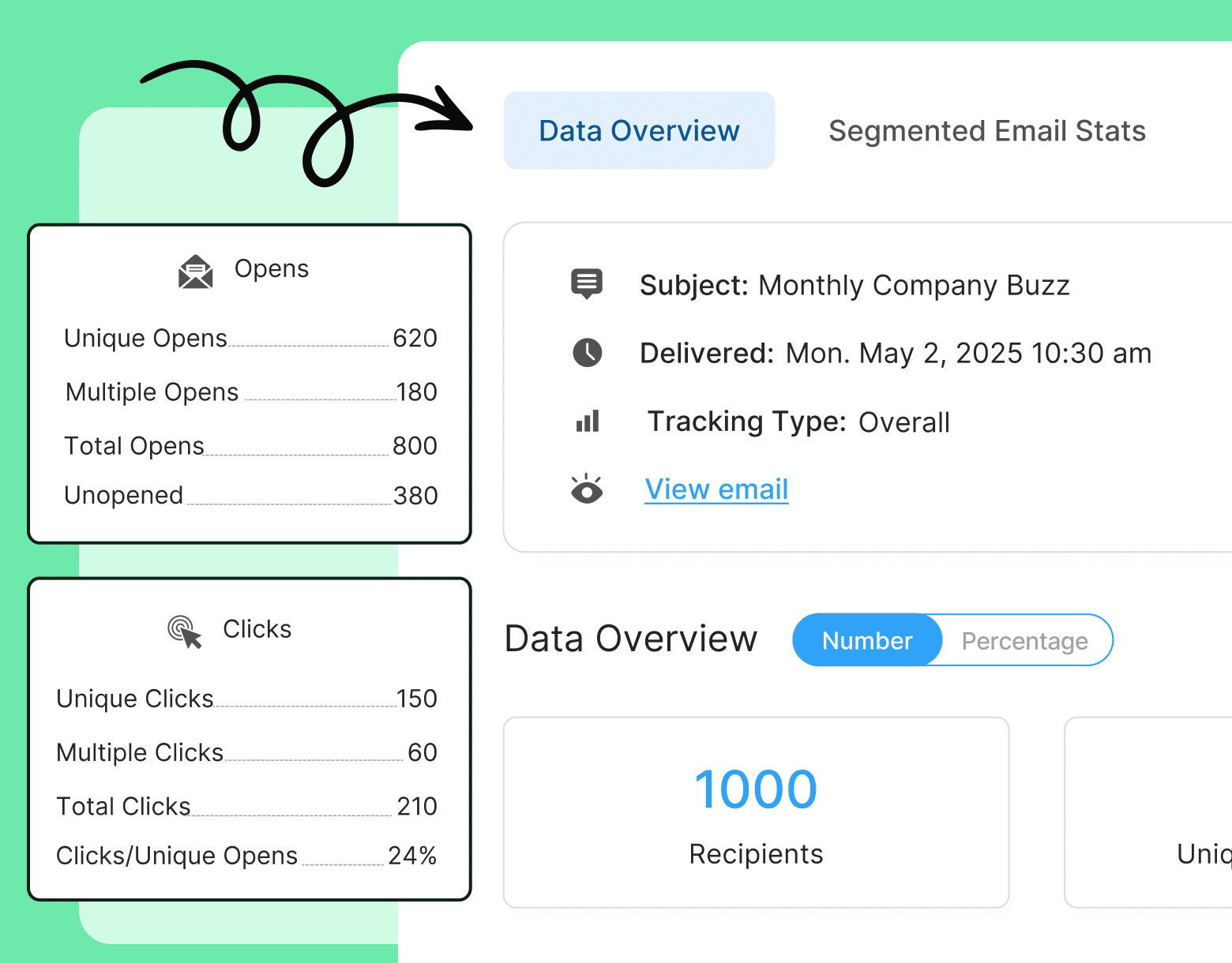
Step 4: Examples of employee engagement survey questions to use
Not sure what to ask? Here are examples of strong employee engagement survey questions you can include in your next employee engagement survey:
Manager effectiveness
- My manager provides helpful and timely feedback. [Y/N]
- I feel comfortable discussing challenges with my manager. [Y/N]
Recognition & value
- I feel appreciated for the work I do. [Y/N]
- My contributions are recognized by my team and leadership. [Y/N]
Growth & development
- I have access to resources to grow in my role. [Y/N]
- I see a clear path for career advancement. [Y/N]
Well-being & work-life balance
- I feel supported in maintaining a healthy work-life balance. [Y/N]
- My mental health and well-being are taken seriously here. [Y/N]
Open-ended
- What’s one thing the company could improve to enhance your work experience?
These employee engagement survey questions are designed to uncover insights that lead to real, measurable action.
BONUS: Want to make your employee engagement survey more fun? Use these fun employee survey questions for some inspiration.
Step 5: Run and distribute your employee engagement survey effectively
You’ve built the survey—now it’s time to launch it. How you distribute your employee engagement survey can affect both participation and trust.
Follow these best practices for survey distribution:
- Choose the right timing: Avoid busy seasons, product launches, or performance review periods.
- Use the right channels: Send your survey using tools like ContactMonkey to embed it directly in internal emails via Outlook or Gmail. Plus, learn how else you can use surveys in internal emails.
- Keep it mobile-friendly: Ensure surveys can be completed easily on any device.
- Maintain anonymity: Reinforce that feedback is confidential to encourage honest responses.
- Track participation: Monitor completion rates in your employee engagement survey tool and follow up thoughtfully.
PRO TIP: Don’t let the survey run indefinitely—set a clear deadline and communicate it. Then, prepare to share and act on the employee engagement survey results (more on that next).
Watch ContactMonkey LIVE in action
Join live demo
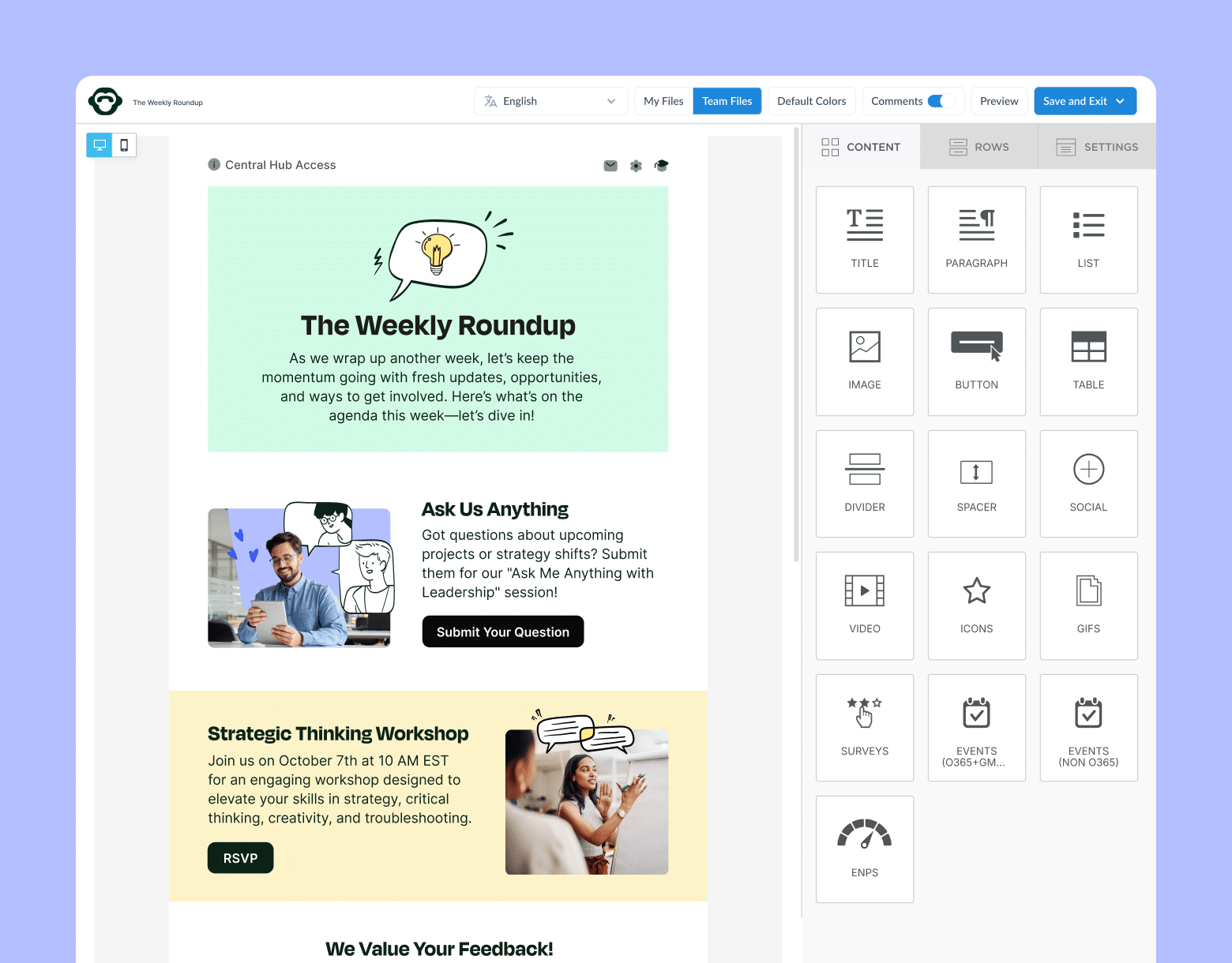
Post Employee Engagement Survey Action Plan
So you’ve hit send, collected responses, and now you’re staring at a dashboard full of charts, comments, and scores. What now?
Running an employee engagement survey is only half the job. What you do with those employee engagement survey results—that’s where the real impact happens.
Here’s your employee engagement survey results action plan:
Step 1: Measure and analyze employee engagement survey results
Once your survey responses are in, it’s time to dig into the data. The goal isn’t to fix everything immediately—it’s to understand where engagement is thriving and where it’s falling short.
Why this is important: Without analysis, your employee engagement survey results are just numbers. Insight helps you prioritize action and avoid wasting time on the wrong fixes.
Tips to execute:
- Segment responses by team, role, tenure, or location.
- Look for patterns—are certain groups consistently less engaged?
- Identify your top engagement drivers and low-performing areas.
Example: You notice employees under 6 months tenure score low on “I feel connected to the company’s mission.” You flag onboarding and values training for review.
Considerations:
- Use your employee engagement software to visualize trends.
- Benchmarks are useful, but internal year-over-year trends are often more telling.
- If you used an employee engagement survey template, customize future surveys based on what emerges.
PRO TIP: Slice the data in multiple ways to measure employee feedback before drawing conclusions. What looks like a company-wide issue might be isolated to one team or region.
Step 2: Share your employee engagement survey results transparently
Employees want to know their feedback matters. If you go silent after the survey, future participation will drop—and trust will erode.
Why this is important: Transparency builds credibility. When employees see their input acknowledged, they’re more likely to engage in future surveys and initiatives.
Tips to execute:
- Share a topline summary within two weeks of survey completion.
- Use charts, infographics, and team quotes to keep it digestible.
- Highlight both positive themes and areas needing improvement.
Example: You send a company-wide email summarizing the top 3 engagement wins and 3 areas for growth, paired with a visual scorecard and a “What’s next” timeline.
Considerations:
- Explain how results will inform upcoming actions or decisions.
- Keep messaging clear and jargon-free.
- Tailor communication for different departments or locations.
PRO TIP: Use an internal email tool like ContactMonkey to embed highlights and pulse follow-ups directly into Outlook or Gmail. Bonus: add emoji reactions or 1-click polls to keep the feedback loop going.
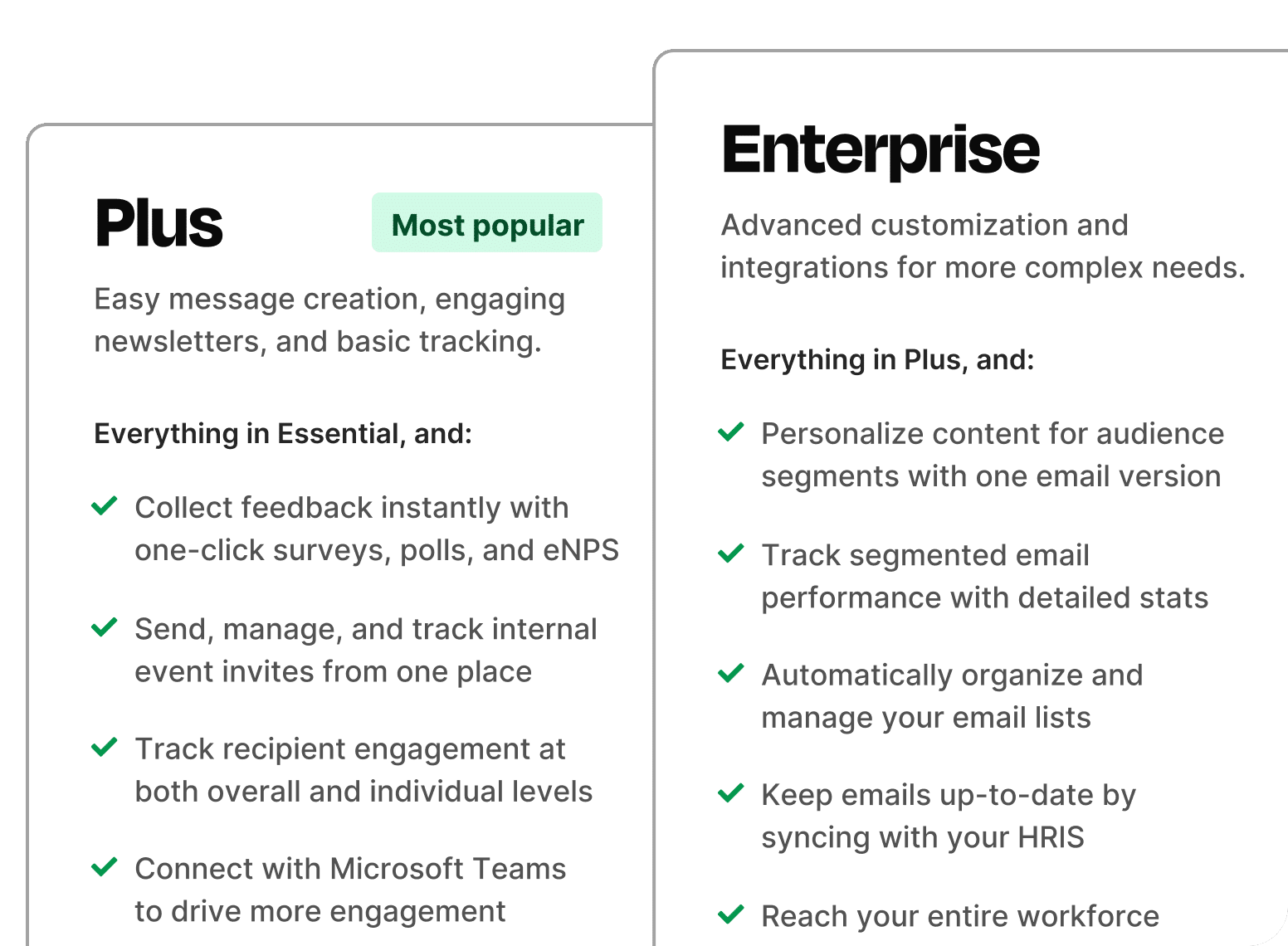
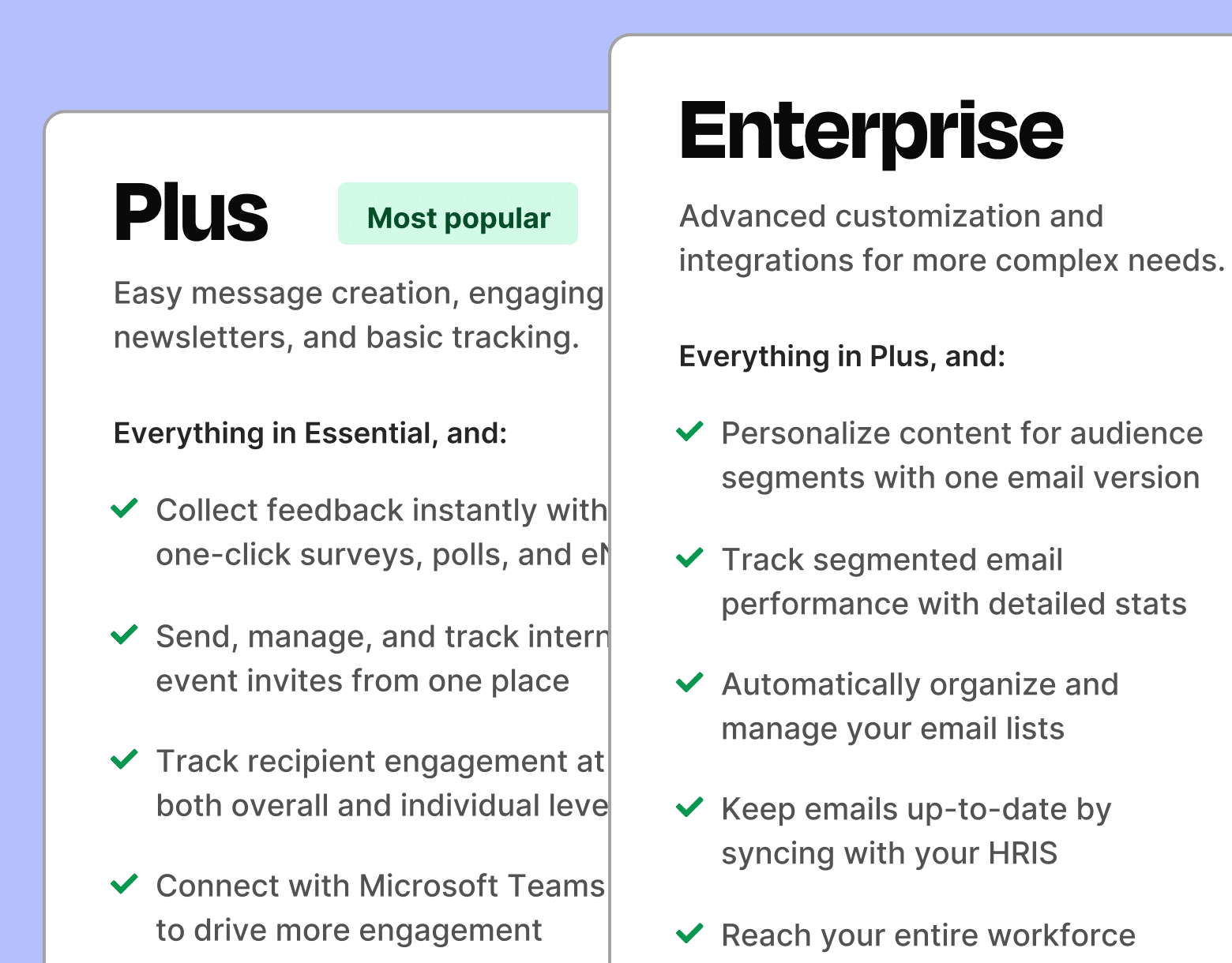
Step 3: Take meaningful action based on employee engagement feedback
If your employee engagement survey questions uncovered themes like lack of recognition or unclear goals, now’s your chance to act. Create a roadmap with short-, medium-, and long-term changes. You don’t need to fix everything all at once. But you do need to show momentum.
Why this is important: Action shows employees you’re not just listening—you’re responding. That builds trust, increases retention, and keeps the cycle of engagement alive.
Example: If your employee engagement survey reveals low scores in career development, your short to long term action plan could look like:
- Short-term: Managers host 1:1 feedback sessions this month.
- Medium-term: Launch a recognition program or refresh onboarding.
- Long-term: Invest in leadership training based on consistent feedback patterns.
Considerations:
- Don’t overpromise—just show steady progress.
- Tie actions back to specific employee engagement survey questions to reinforce accountability.
- Track changes using future surveys or pulse check-ins.
PRO TIP: Loop employees in at every stage. Share what’s happening, why, and how it ties back to their feedback.
Step 4: Follow up with mini pulse surveys to measure progress
Once you act, follow up. Mini pulse surveys help you gauge whether your initiatives are working—and keep the feedback cycle continuous.
Why this is important: Pulse surveys help you adapt in real-time. They show employees that feedback is ongoing, not a one-time event.
Tips to execute:
- Use focused questions like, “Do you feel more recognized this month?”
- Keep surveys short—5 questions max.
- Space them out monthly or quarterly depending on your goals.
Example: After launching a new recognition program, send a pulse survey two weeks later with a single question: “Have you felt more recognized at work recently?”
Considerations:
- Use the same employee engagement survey tools to track participation and trends.
- Share quick wins from pulse survey feedback to maintain momentum.
- Avoid over-surveying to prevent fatigue.
PRO TIP: Pulse surveys are a great place to test new employee engagement survey questions or topics before including them in your next full survey.
Step 5: Refine your employee engagement strategy
Employee needs evolve and so should your approach. Use insights from each survey cycle to improve your employee communicatioms— everything from your questions to your communications to your company culture.
Why this is important: Running the same employee engagement survey year after year without adapting can cause participation to drop and insights to plateau. Iteration keeps your strategy fresh and impactful.
Tips to execute:
- Revisit and revise your employee engagement survey questions based on past results.
- Add or rotate in new employee engagement survey topics based on shifting priorities (e.g., hybrid work, DEI, well-being).
- Assess whether your current employee engagement survey software and tools are meeting your needs—or if it’s time to upgrade.
Example: If feedback around communication has improved but concerns around workload have risen, shift your next survey’s focus to dig deeper into resourcing and support.
Considerations:
- Use a mix of quantitative results and qualitative feedback to shape future iterations.
- Involve managers or employee resource groups in refining future survey design.
- Look for employee engagement KPI patterns that align with broader business KPIs.
PRO TIP: Build a year-round internal communications content calendar that integrates surveys, feedback loops, and check-ins—so you’re continuously learning and improving.
Why Start Your Employee Engagement Strategy with ContactMonkey
You don’t need a PhD in psychology—or a team of analysts—to run a great employee engagement survey in 2025. With the right employee engagement survey software, you can turn a simple set of questions into a strategic advantage for your organization.
Here’s a recap of your survey toolkit:
- Use an employee engagement survey template to launch fast.
- Focus on relevant employee engagement survey topics.
- Choose strong, actionable employee engagement survey questions.
- Analyze your employee engagement survey results deeply.
- Act on feedback—and communicate clearly using trusted employee engagement survey tools.
And here’s why you should use ContactMonkey to launch employee engagement surveys:
- With the Email Template Builder Feature, build and send mobile-friendly employee engagement and pulse surveys in minutes.
- Track clicks, open rates, and responses—all in one place through the Analytics Dashboard Feature.
- Thanks to the List Management Feature, segment audiences by department, location, or employment type.
- Visualize your impact with real-time analytics and reporting.
What’s next? Turn employee feedback into real business results—without switching platforms or chasing data. Book a 15-minute call with our experts and see how ContactMonkey makes employee engagement effortless.



